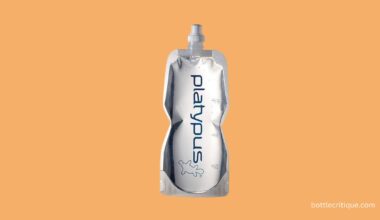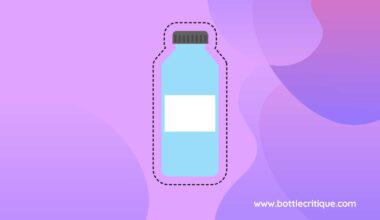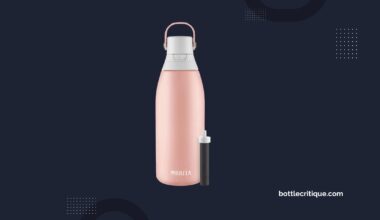Ever taken a sip from your water bottle only to be met with an unpleasant metallic taste? If yes, it’s time to put an end to your woes! Every water bottle user deserves a clean, pure, and metal-free drinking experience. This article aims to help you achieve just that. So, let’s explore some quick, easy, and effective steps to remove that off-putting metallic taste from your water bottle.
Why does this happen?
Often, the metallic taste can be traced back to residue build-up from the water itself or from the bottle’s material, especially if it is stainless steel. But don’t worry, it’s not a permanent situation and can be fixed with a little effort.
Now, let’s dive right into the different ways of getting rid of the metallic taste from your water bottle. Our instructions are easy to follow, practical, and proven to make your water taste fresher. Ready to refresh your drinking experience?
Why does my water bottle have a metallic taste?
Wondering why your water bottle has a metallic taste? It’s a common issue that many people face. This usually happens when metal ions from the bottle’s interior come into contact with the water. It’s particularly common in bottles made of stainless steel or aluminum.
- Stainless steel bottles: These bottles are praised for their durability, but they can sometimes give water a metallic taste. This taste is often due to the bottle not being cleaned properly or the stainless steel itself interacting with the water.
- Aluminum bottles: Aluminum water bottles can also cause this issue. The metallic taste here is usually due to the protective liner inside the bottle, designed to prevent the aluminum from leaching into the water, starting to degrade.
Besides the type of bottle, other factors can contribute to this unpleasant taste. For instance, the water quality and its pH level can affect how it reacts with the bottle’s interior. Low-quality water tends to have a higher pH level, which can increase the leaching of metal ions.
Lastly, remember that your taste buds can play a role too. Some people are more sensitive to the taste of metal ions in water than others, so what tastes metallic to you might not taste the same to someone else.
How does metallic taste affect your health?
Ever wondered why a metallic taste from your water bottle could pose a problem to your health? Primarily, this metallic taste often signals the presence of metal ions such as iron, copper, zinc, or lead that have leached into your water. These ions can have varying effects on your health. Let’s break it down:
- Iron: While iron is an essential nutrient, excessive consumption can lead to iron overload. This condition may increase your risk of certain infections and is linked to conditions such as diabetes and heart disease.
- Copper: Small amounts of copper are necessary for our bodies, but ingestion in large quantities can cause nausea, vomiting, and diarrhea. Long-term exposure can lead to liver or kidney damage.
- Zinc: While zinc is also a needed nutrient, too much of it can cause nausea, vomiting, loss of appetite, stomach cramps, diarrhea, and headaches.
- Lead: Lead is particularly harmful. Even low levels of exposure can cause serious health problems, particularly in children. High levels can damage the brain and kidneys, among other organs.
This is not to alarm you, but to keep you informed. Not all metallic tastes in water are harmful, but if you’re consistently noticing a metallic taste, it may be worth testing your water for these ions. After all, it’s better to be safe than sorry, right?
Tips to prevent metallic taste in water bottles
So, you’ve got your water bottle cleaned up and taste-free. Great job! Now, how do you prevent that metallic taste from coming back? Here are some helpful tips:
- Avoid storing acidic liquids: Acidic beverages, such as fruit juices or coffee, can cause the metallic taste. Stick to water or non-acidic drinks.
- Maintain cleanliness: A clean bottle is less likely to develop a metallic taste. Wash your bottle regularly and thoroughly.
- Go for high-quality bottles: Low-quality bottles are more prone to give off a metallic taste. Choose a high-quality stainless steel bottle to avoid this issue.
- Use a bottle liner: Some bottles come with a liner that prevents a metallic taste. Look for these kinds of bottles.
Remember, prevention is better than cure. By following these tips, you can enjoy fresh-tasting water all the time. Try and see the difference!
“An ounce of prevention is worth a pound of cure!”
Table: Comparing Water Bottle Materials
| Material | Pros | Cons |
|---|---|---|
| Stainless Steel | Durable, maintains temperature well | Can have a metallic taste if not properly maintained |
| Plastic | Lightweight, inexpensive | Can leach chemicals, not as durable |
| Glass | Does not affect taste, easy to clean | Breakable, heavy |
Choosing the right material for your water bottle is another factor in preventing a metallic taste. Each material has its pros and cons. Consider your needs and make an informed choice.
How to identify the source of the metallic taste in your water bottle
Ever taken a sip of water from your bottle and been hit with a strange, metallic taste? It’s not exactly refreshing, is it? So, what’s causing this unwelcome flavor? Let’s dive in and find out.
Firstly, the metallic taste in your water bottle could be due to the water source. Different water sources (such as city water or well water) have varying mineral contents that can lead to a metallic flavor. Secondly, the bottle material can also be a culprit. Stainless steel bottles, for instance, may impart a metallic taste to the water if not cared for properly. Lastly, if the bottle isn’t cleaned regularly and thoroughly, bacteria and mold can grow, resulting in a strange taste.
Determining the Source
- Check your Water Source: Start by tasting the water directly from the tap. If it has a metallic taste, the issue isn’t with your bottle but with your water source. In this case, consider using a water filter or switching to bottled water.
- Examine the Bottle Material: If you’re using a stainless steel or metal bottle, try switching to plastic or glass. If the taste disappears, the material of your bottle is likely the source of the metallic taste.
- Inspect for Proper Cleaning: A dirty bottle can also cause your water to taste off. If your bottle isn’t cleaned regularly, bacteria and mold can grow inside, creating a metallic or otherwise unpleasant taste.
Now that you’ve identified the source of the metallic taste, you can take steps to eliminate it and enjoy refreshing, taste-free water once again.
How to clean your water bottle to remove the metallic taste
Have you ever taken a sip from your water bottle, only to be met with a peculiar metallic taste? This unpleasant experience can be off-putting, but don’t worry, it’s not permanent. Here’s a simple, step-by-step guide on how to clean your water bottle to remove that undesirable metallic taste.
What You’ll Need:
- White Vinegar: An excellent, natural cleaning agent that helps in removing metallic taste.
- Baking Soda: Another potent cleaner that neutralizes the metallic flavor.
- Soft Brush: To scrub the interior of your water bottle without scratching it.
- Warm Water: Helps dissolve the cleaning agents and rinse your bottle thoroughly.
Step-by-Step Guide:
- Prepare your Cleaning Solution: Mix one part white vinegar with five parts warm water in your bottle. Add a teaspoon of baking soda. Be careful, as the solution will fizz initially.
- Shake Well: Close the bottle and give it a good shake. This helps the cleaning solution reach every corner of your bottle.
- Let it Soak: Leave the solution in your bottle for about 15-20 minutes. This allows the solution to do its work and eliminate the metallic taste.
- Scrub: After the soak, take your soft brush and gently scrub the interior of your water bottle. Pay special attention to the bottom and the corners.
- Rinse: Rinse your bottle thoroughly with warm water. Make sure all the cleaning solution is completely rinsed out.
And there you have it! A clean, fresh-tasting water bottle, free of any metallic taste. Remember, regular maintenance is key to keeping your bottle in top shape. Make it a habit to clean your bottle after every few uses to keep it tasting fresh and clean.
Natural remedies to remove metallic taste from your water bottle
So, you’ve tried washing your water bottle, but the metallic taste stubbornly lingers? Don’t worry! You can remove this unpleasant taste using simple, natural remedies. These remedies not only clean your water bottle but also leave it smelling fresh.
Vinegar Rinse
Plain white vinegar, due to its acidic nature, can effectively remove the metallic taste from your bottle. Here’s how:
- Fill your water bottle halfway with white vinegar.
- Add water until the bottle is full.
- Seal the bottle and shake it thoroughly.
- Let it sit for about 15 minutes, then rinse thoroughly with warm, soapy water.
Baking Soda Scrub
Baking soda is another household item that can help in removing metallic taste. Here’s what you need to do:
- Sprinkle a generous amount of baking soda into your water bottle.
- Fill the bottle with warm water.
- Seal the bottle and shake it well.
- Allow it to sit for a few hours, then rinse thoroughly.
Lemon Juice Soak
Lemon juice is a natural deodorizer that can also help in eliminating the metallic taste from your water bottle. Follow these steps:
- Squeeze the juice of a whole lemon into your water bottle.
- Add warm water until the bottle is full.
- Let the solution sit in the bottle overnight.
- The next morning, rinse the bottle thoroughly.
Remember, the key to removing the metallic taste from your water bottle is thorough rinsing. Rinse your bottle with lots of warm, soapy water after using any of these natural remedies. You’ll be sipping crisp, clean water from your bottle in no time!
Using chemical solutions to remove metallic taste from your water bottle
Have you ever taken a nice long drink from your water bottle only to be greeted with an unpleasant metallic taste? This experience can be off-putting, but don’t worry – it’s not permanent. There are chemical solutions available that can effectively remove this metallic taste from your water bottle. These solutions are safe to use and easy to apply.
Here’s how you can use these solutions:
- Choose the right solution: Several commercial cleaning solutions are specifically designed to remove metallic taste from water bottles. Look for one that suits your needs and budget. Remember, good quality doesn’t always mean high price.
- Follow the instructions: Read the instructions on the cleaning solution bottle carefully. Typically, you’ll need to mix a specified amount of the solution with water and fill your water bottle with this mixture.
- Let it sit: Allow the cleaning solution to sit in your water bottle for a few hours. This will give it enough time to eliminate the metallic taste completely.
- Rinse thoroughly: After the solution has done its job, make sure to rinse your water bottle thoroughly. You want to ensure all the cleaning solution is completely washed away.
While chemical solutions can be effective, they might not always be your first choice. The idea of using chemicals to clean something that you drink from can be daunting. However, rest assured that these cleaning solutions are safe to use. They are designed specifically for water bottles and are non-toxic. You won’t ingest any harmful chemicals as long as you rinse your water bottle thoroughly after cleaning.
Note: Always remember to rinse your water bottle thoroughly after using a chemical cleaning solution. This will ensure that no traces of the solution remain, ensuring you a clean, fresh-tasting drink every time.
How to maintain your water bottle to avoid metallic taste in the future
It’s crucial to take proactive steps to prevent the buildup of a metallic taste in your water bottle. Not only will this improve your hydration experience, but it will also extend the lifespan of your water bottle. So, how can you keep your water bottle fresh and metallic taste-free?
Regular Cleaning
Even if it’s only been filled with water, your bottle should be cleaned daily. Here’s a simple routine you can follow:
- Empty the bottle – Pour out any leftover liquid to start fresh.
- Rinse with warm water – Warm water is more effective at removing residue.
- Use a mild detergent – A small amount of gentle, fragrance-free soap can help remove any stubborn flavors.
- Scrub the interior – Use a bottle brush to reach all parts of the bottle, especially if it has a narrow neck.
- Rinse thoroughly – Make sure to rinse out all the soap to avoid any soapy taste in your next drink.
- Air dry upside down – This prevents moisture from pooling at the bottom of the bottle and encourages complete drying.
Periodic Deep Cleaning
Periodically, it’s important to give your water bottle a deep cleaning to eliminate any lingering bacteria or flavors. This can be done in a few simple steps:
- Fill the bottle with a vinegar solution – Use a 1:1 ratio of white distilled vinegar and warm water.
- Let it sit – Leave the solution in the bottle for about 15 minutes.
- Rinse thoroughly – Rinse until the vinegar smell is gone.
Proper Storage
When not in use, store your water bottle in a cool, dry place with the lid off to allow it to remain dry and free from any musty odors.
Remember, a clean water bottle is not only better tasting but also healthier. With regular care and maintenance, you can avoid the metallic taste and keep your bottle in good condition for years to come.
Alternative water bottles to consider if metallic taste persists
If you’ve tried all our tips and your water bottle still has a metallic taste, it may be time to consider an alternative. Let’s dive into some other types of water bottles worth giving a shot.
Stainless Steel Bottles
While stainless steel bottles can sometimes contribute to a metallic taste, not all are created equal. Look for high-quality, food-grade stainless steel bottles. These are often made with a special lining to prevent any metallic taste.
Glass Water Bottles
Glass water bottles are a fantastic option if you’re looking to avoid any strange tastes. They don’t impart any flavors into your water, and they’re also incredibly easy to clean. However, they can be more fragile than their metal or plastic counterparts.
Plastic Water Bottles
If you’re not a fan of the weight of metal or glass bottles, plastic could be a good option for you. Look for bottles made of BPA-free plastic to ensure the safest drinking experience.
Copper Water Bottles
Copper water bottles not only prevent a metallic taste but also have potential health benefits. They are known for their antimicrobial properties and their ability to keep water cold.
Note: Always clean your new water bottle thoroughly before first use, no matter the material. This will ensure the best tasting water.
Remember, the right water bottle for you is the one that meets your specific needs and taste preferences. So don’t be afraid to try a few different types until you find your perfect match!






